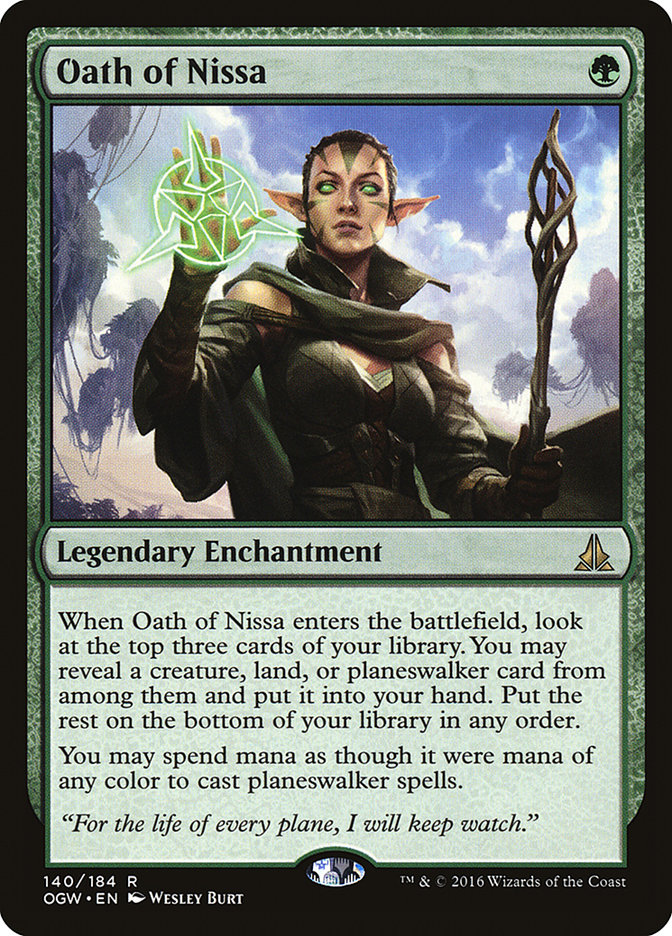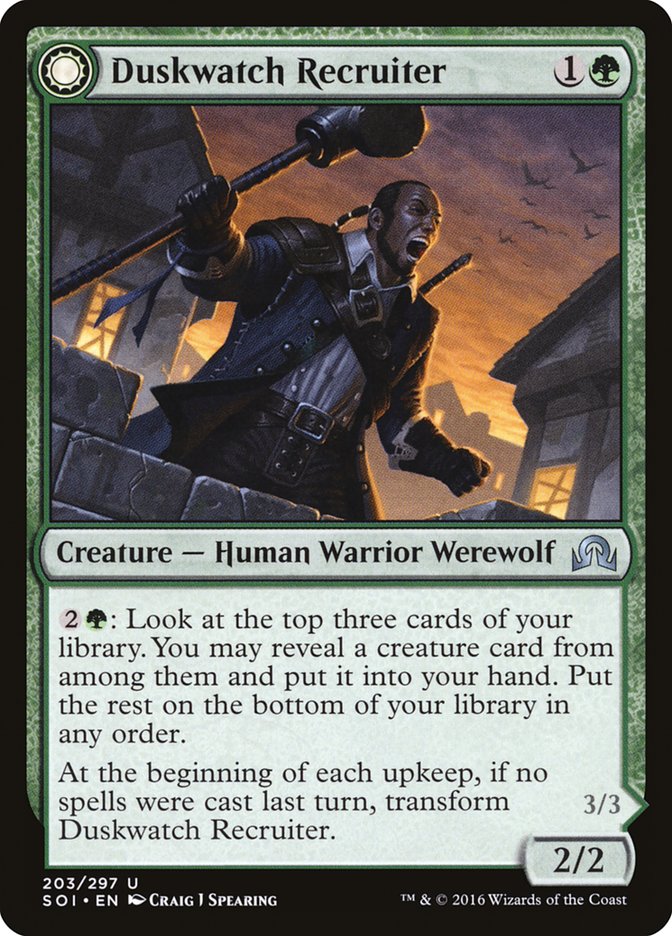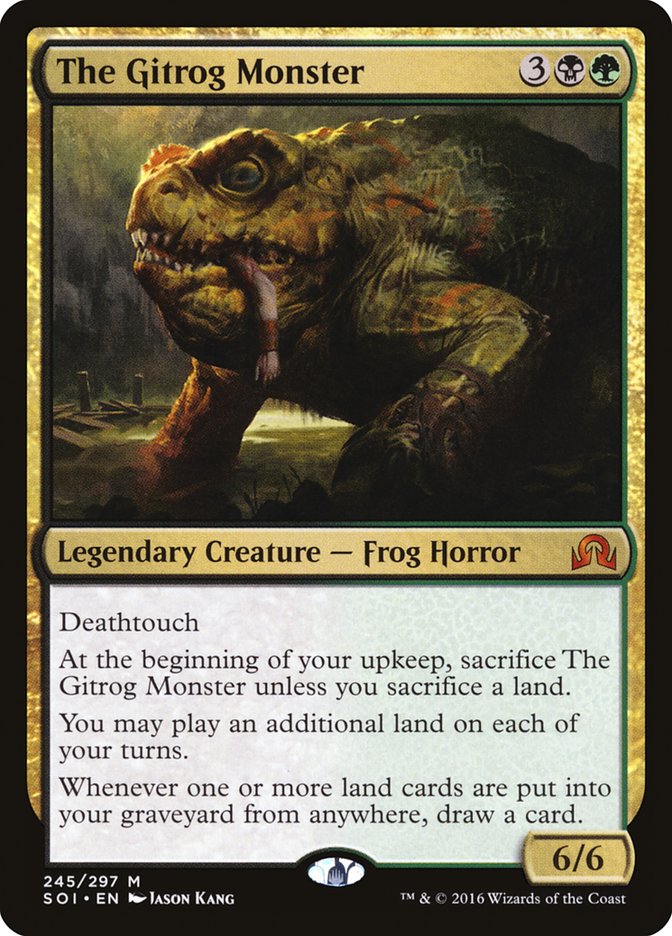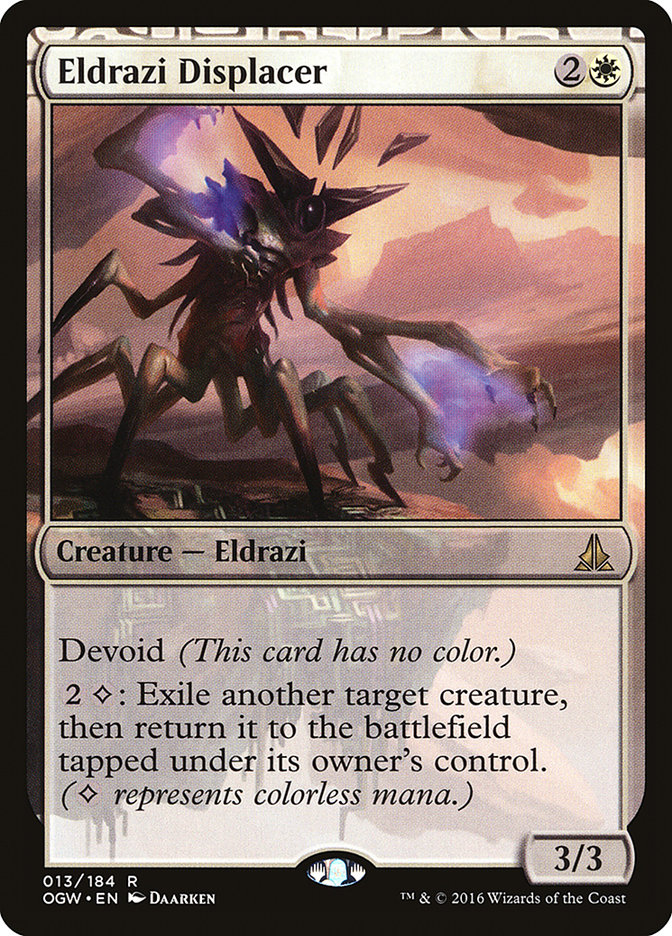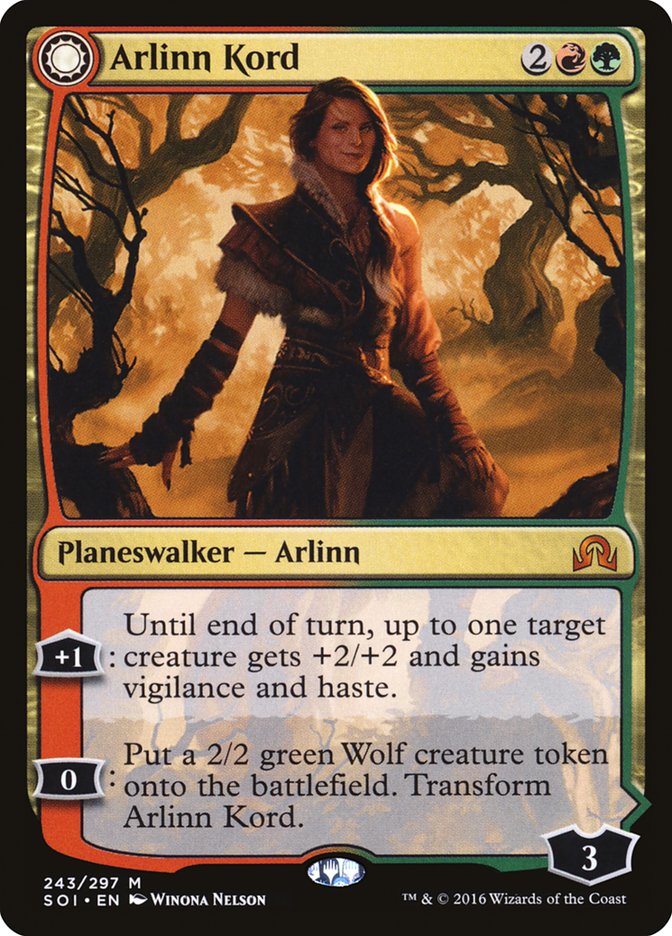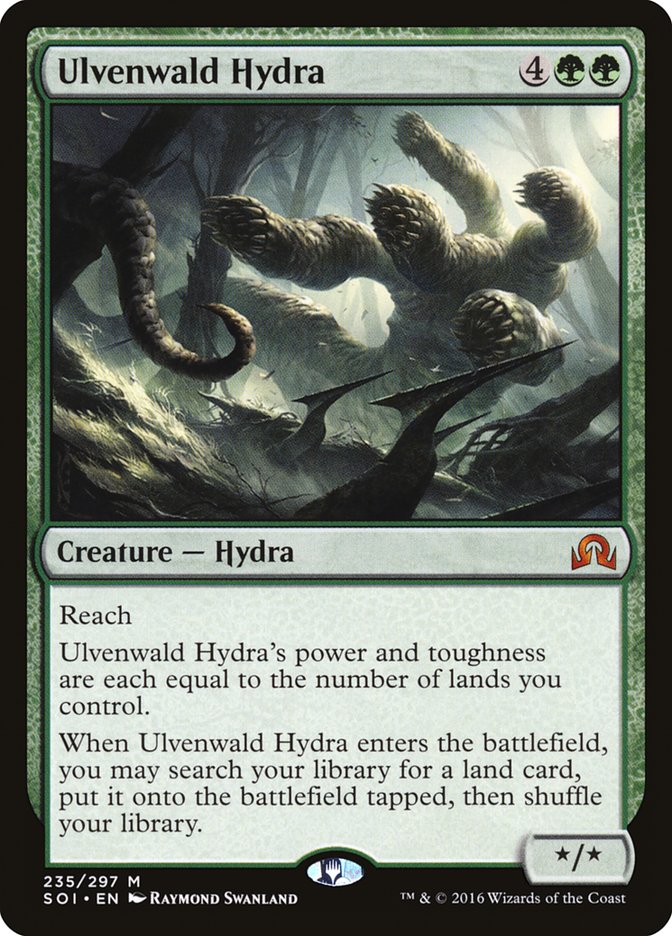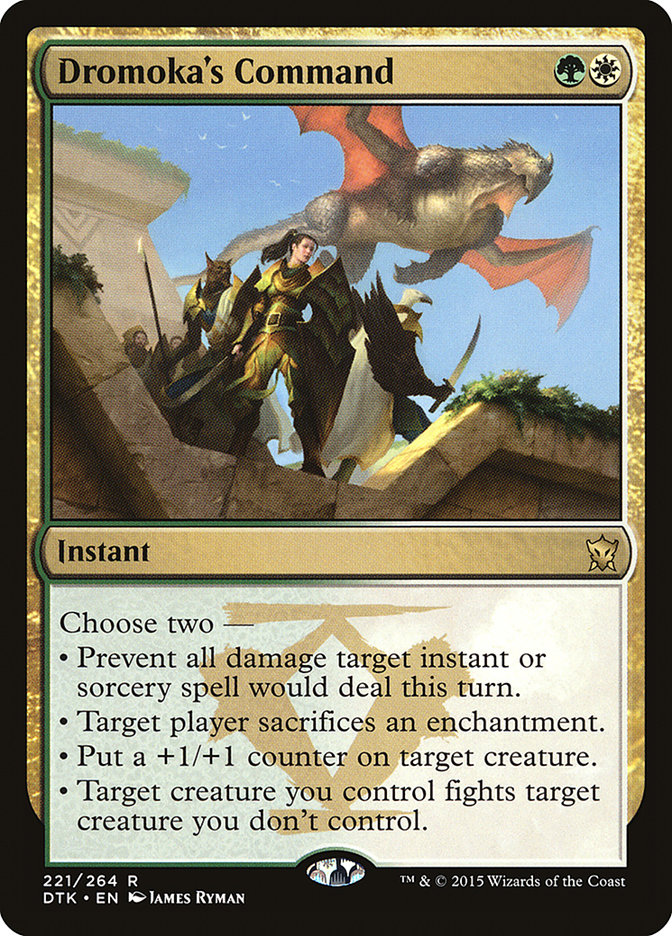Standard is in full swing after the Pro Tour, and as always, we’re seeing a lot of developments and innovation.
After Day 1 of Grand Prix: Toronto, it was looking like we might be heading into a format where G/W Tokens was the clear best deck. After all, not only did it win the Pro Tour, but it also had an impressive win percentage throughout the tournament. When Toronto coverage reported 39 of the Top 100 decks in Day 1 were G/W, it looked like we might be headed toward a very imbalanced format.
Fortunately, when it was all over, only two G/W decks made the Top 8, and Esper Dragons won the tournament.
The real highlight of this weekend, to me, is the number of new decks that made splashes this weekend that we didn’t see at the Pro Tour.
Consider Mothkebab’s second-place deck from the MOCS Playoff event on Saturday:
Creatures (25)
- 2 Dragonlord Silumgar
- 1 Shaman of Forgotten Ways
- 2 Nissa, Vastwood Seer
- 1 Kalitas, Traitor of Ghet
- 4 Sylvan Advocate
- 4 Thought-Knot Seer
- 3 Deathcap Cultivator
- 3 Tireless Tracker
- 2 The Gitrog Monster
- 3 Duskwatch Recruiter
Lands (26)
Spells (9)

This deck is about as hard to process as The Gitrog Monster itself. I mean, I get it, it’s a typical G/B Midrange deck splashing Dragonlord Silumgar, but the individual card choices are a little exotic. One Shaman of Forgotten Ways, two Warping Wail, three Deathcap Cultivator? These are unusual numbers of things.
That said, I don’t mean to sound too critical of this deck. I’m a huge fan of Oath of Nissa, Duskwatch Recruiter, and Tireless Tracker, and I love the way that Tireless Tracker plays with The Gitrog Monster.
This deck is certainly full of great cards. It’s a little lighter on disruptive elements like discard and removal than decks in this vein often are, but I think a big part of that might be that the creatures are just better.
The Gitrog Monster is actually a fairly impressive creature. Not many things kill it and its text box is very good. The problem with it is that it’s not great to get bounced by Reflector Mage, but this deck deals with that by presenting plenty of other targets to get that out of the way first and Thought-Knot Seer to really clear the way,
One really amusing note about this deck is the extent to which it preys on its own removal suite, leaning on four Ultimate Price while playing Thought-Knot Seer, The Gitrog Monster, and Dragonlord Silumgar. It’s like the deck was built around the idea that Ultimate Price is the best card in the format, so you have to both play with it and play creatures that expect others to have it.
Basically, this list assumes that it’s a level ahead of everyone else, because if everyone picks up this deck, the way to win the mirror is to tune the removal spells to be able to interact with the bigger creatures (but, of course, that likely means Ruinous Path, which is a huge step down, which is why this deck respects Ultimate Price so much).
While Seth Manfield and others on Team East West Bowl were debuting their take on Cryptolith Rite plus Collected Company, the four-color deck featuring the Brood Monitor combo, Ben Weitz (BSWeitz on MTGO) was piloting it to the Top 8 of the MOCS Playoff.
Creatures (29)
- 4 Elvish Visionary
- 4 Catacomb Sifter
- 3 Brood Monitor
- 2 Zulaport Cutthroat
- 4 Reflector Mage
- 4 Eldrazi Displacer
- 4 Duskwatch Recruiter
- 4 Loam Dryad
Lands (24)
Spells (7)
Sideboard

I’m not sure what I think of this deck. It looks like the mana gets a lot worse to support cards that don’t really change what the deck’s doing that much. The fact that it can kill without attacking by draining the opponent out with Zulaport Cutthroat triggers would be a new dimension for a lot of decks, but B/G Company already routinely does that. Reflector Mage is good at slowing down opposing attackers, but I’d found that Nantuko Husk was also great at that, as it’s just very hard to attack into Nantuko Husk and a couple of 1/1s.
Eldrazi Displacer offers a great mana sink for when you have Cryptolith Rite, but between Catacomb Sifter and Collected Company, the deck was already good at finding Duskwatch Recruiter, which is really all the mana sink you need most of the time.
Maybe the big selling point is cutting Blisterpod, a low-impact card, but I really like having a lot of one-cost creatures in my Cryptolith Rite deck to really get things going faster.
I think the biggest advantage of this build is that Reflector Mage allows it to remove a Kalitas, Traitor of Ghet in Game 1, and that’s a big deal. Also, while G/B can often find a Duskwatch Recruiter, Eldrazi Displacer really is another high-value addition, especially if the deck to beat has four Hangarback Walkers and a bunch of other ways to make tokens. Resetting an Avacyn before it can flip and Wrath you is also pretty great.
Outside of the Top 8, the MOCS Playoffs had a few other interesting decks, setting my own 11th place aside for a moment, Jacob Wilson (ZYXWVUTSRQPON) played a W/U Midrange deck that mostly revolves around Dragonlord Ojutai, with Eldrazi Skyspawner and Knight of the White Orchid to help cast it early in the game, and Always Watching for the “always hexproof” combo.
Creatures (22)
- 4 Knight of the White Orchid
- 4 Dragonlord Ojutai
- 4 Eldrazi Skyspawner
- 4 Reflector Mage
- 2 Archangel Avacyn
- 4 Thraben Inspector
Planeswalkers (2)
Lands (25)
Spells (11)

I believe this is the first time I’ve seen four Silumgar’s Scorn with only four Dragons, but there are so few counterspells being played right now that they’re likely very well-positioned, as people routinely try to cast spells on their turn that cost four or more mana.
When I’ve tried to build decks like this, I always want to include green cards, but the mana just doesn’t work. Jacob is playing the full twelve U/W lands and now colorless lands because the requirements of Knight of the White Orchid and Silumgar’s Scorn are so intense. I like the discipline and commitment to functional mana here. I’d really like to see one more Always Watching, though. I feel like the combo with Ojutai is so strong that, once I’ve gone through all the trouble of making a deck that makes good use of both cards, I really want to get them together as frequently as possible.
Tulio Jaudy finished in 16th with Mono-White Eldrazi. This deck is really straightforward: twenty creatures, eight removal spells, the Gideon, Ally of Zendikar plus Secure the Wastes combo, and 25 lands. Hedron Crawler allows for turn 3 Thought-Knot Seers or Gideons, and Secure the Wastes is also powering Westvale Abbey.
Creatures (20)
Planeswalkers (4)
Lands (25)
Spells (11)

Previously, we’ve mostly seen W/B or W/R Eldrazi decks, but I like this take. I think Spatial Contortion complements the white removal well, and the mana here is so much better than the mana when you try to add another color. You have to give up on creature-lands, but you get a lot of good colorless utility lands instead. Eldrazi Displacer isn’t as strong here as it is in those decks that have juicier blink targets, but I think it’s good enough that your opponent has to kill it most of the time either way.
While the density of Platinum pros and other very dedicated players helps bring a lot of new ideas to the MOCS Playoffs, it certainly wasn’t the only source of innovation this weekend.
The #SCGMKE Classic in Milwaukee (another event I played in) was won by Rob Birdsall with Naya Planeswalkers, and I really don’t know what to make of this deck.
Creatures (9)
- 1 Dragonlord Atarka
- 1 Dragonlord Dromoka
- 2 Nissa, Vastwood Seer
- 1 Linvala, the Preserver
- 4 Sylvan Advocate
Planeswalkers (10)
- 2 Gideon, Ally of Zendikar
- 2 Chandra, Flamecaller
- 2 Nissa, Voice of Zendikar
- 2 Nahiri, the Harbinger
- 2 Arlinn Kord
Lands (24)
Spells (17)

Oath of Chandra obviously looks great here, as does Oath of Nissa, and assembling multiple planeswalkers on the battlefield is always great. The removal spells complement each other and the planeswalkers well, and Secure the Wastes plays well with Arlinn Kord; Gideon, Ally of Zendikar; and Nissa, Voice of Zendikar.
I generally think Arlinn Kord is a fairly weak card, but I like the decision to use it to complement other planeswalkers rather than to try to augment an aggressive strategy. Its plus abilities are mismatched on the sides of the card such that they don’t play well with its natural play pattern.
You want to make a Wolf the turn you cast Arlinn, because you probably don’t have a creature to give haste; but then, if you were using it as an aggressive card, you’d be likely to want to give haste to the creature you play on the next turn; but if you’ve made a Wolf, it’s no longer on the side that gives haste, and instead it’s on the side that pumps up your whole team, except you probably don’t have a large team at this point.
If the abilities were the other way, then on turn 4 you’d cast it and make a Wolf, on turn 5 you’d give a big creature haste, and if you drew it late, you might use it as a mini-Overrun the turn you cast it. As is, I think it’s best to just focus on making Wolves and dealing three damage, opportunistically using the other abilities if you happen to find yourself in spots where you want them, rather than building to push them.
As for myself, I played Duskwatch Ramp in the MOCS Playoffs, but then when I heard about G/W’s performance at Grand Prix Toronto, I decided I wanted to try the deck for myself. I played it on Sunday at the Classic in Milwaukee, and Justin played Duskwatch Ramp.
I recorded a set of videos with this deck last week, and I’ve been happy with it. Duskwatch Recruiter and Tireless Tracker are really amazing cards that seem to overperform almost anywhere I try them, and Ulvenwald Hydra has really shined as a card that plays a lot better than it looks (it might be a good card to consider picking up for those of you who are into that kind of speculation).
It’s natural to compare Ulvenwald Hydra to Primeval Titan, and it’s obviously pretty disappointing to only get one land and not get more when you attack, but Primeval Titan is absolutely busted, and Ulvenwald Hydra is a lot bigger than Primeval Titan. When I read it the first time, my brain thought of it as being something like a 6/6, and that’s not only wrong, it’s just not even close. By default, it comes in as a 7/7, which means the first time it attacks it’s probably about an 8/8 on average.
If you follow it up with a second hydra or another ramp spell, it’s even bigger than that, and it’s bigger if you draw it later. In practice, with Rogue’s Passage, this thing can often kill someone by itself in two attacks, and it’s not uncommon for it to hold off Ormendahl, Profane Prince indefinitely. On top of that, opposing Ramp decks or other red decks often just can’t kill it because it has so much toughness.
My experience with G/W Tokens was about what I expected. The power level is very high, but my draws often felt a little clunky. It has a lot of tools available to it, and a lot of ability to change what it’s trying to do in sideboarding, which I like a lot. Because this was my first time playing the deck and I hadn’t really thought about it or talked to anyone, I was actually a little overwhelmed.
In my first round, against G/B Company, I knew I wanted to transition toward being a planeswalker control deck, because it was important to have as many answers as possible to Zulaport Cutthroat, and G/B isn’t very good at attacking, which means they don’t threaten planeswalkers well. So I wanted all the removal, and I know that it can easily become difficult or pointless to attack G/B on the ground, so I wanted to maximize fliers.
I sideboarded out my ground creatures (Sylvan Advocate and Lambholt Pacifist, which I played over Thraben Inspector) because I didn’t think the planeswalkers needed them for help and I didn’t think attacking would be very profitable, but this also meant that I raised my curve a lot and I didn’t have enough early creatures to fight with Dromoka’s Command. I ended up losing because I couldn’t find a third land, so raising my curve looked as bad as possible, but I really just have no idea if I was taking things too far or not.
I had similar issues later, where I just wasn’t sure if I was breaking the fundamentals of the deck too much a lot of the time.
On this note, a bit of advice: something I like to joke about is that I think a lot of players would do better if they just weren’t allowed to sideboard. It’s easy to copy a list and then you’ll have a good sixty cards for Game 1, but if you don’t know what you’re doing, there’s a good chance you’ll just make your deck worse when you change it between games.
We saw this a lot this weekend as people kept putting more reactive cards in their aggressive decks against Justin, greatly decreasing their chances of winning. Justin has inevitability, and their strength was that they could end the game before he got going. Sometimes it’s important to have a removal spell to stop your opponent from stabilizing, but it’s really easy to take this too far.
I’ve found that most of the games that I win against White Aggro with Ramp, for example, are the games where they draw multiple copies of Declaration in Stone. People just get scared of the things the other deck can do, so they bring in anything they can that answers those things rather than really understanding what they matchup is about and playing to their strengths.
It can feel like you’re leaving a lot of value on the table if you don’t sideboard enough, but really, when it doubt, just leave things as they are. It might not be perfect, but there’s almost always a much greater risk in over-sideboarding.


